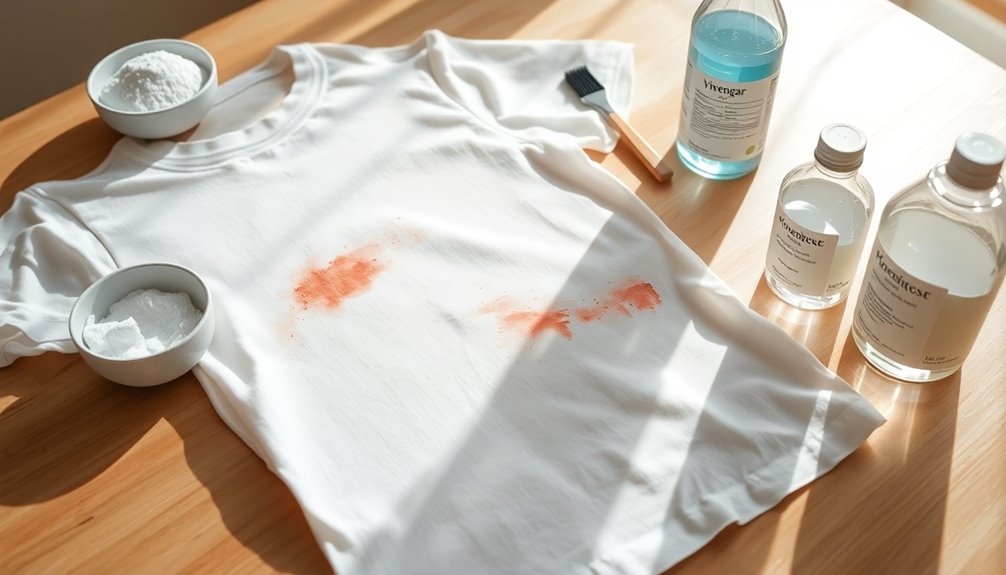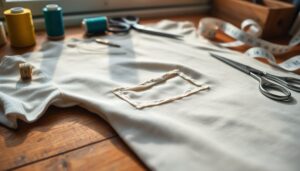You can easily fix bleach stains with a few DIY solutions that are both affordable and effective. Start by rinsing the stained area with cold water to minimize damage. Then, try soaking the fabric in a vinegar solution (1 part vinegar to 2 parts water) for 30-60 minutes, or apply a baking soda paste for 15-20 minutes. Rubbing alcohol can also help restore color; just remember to test it on a hidden spot first. If the stain's extensive, think about using fabric markers or dyeing the garment a darker color. There's even more to take into account for tackling those stubborn stains!
Understanding Bleach Stains
When it comes to bleach stains, many people don't realize how quickly they can occur. You might accidentally spill bleach while cleaning or overuse it in your laundry, leading to faded or discolored spots on your favorite garments.
These bleach stains aren't just minor annoyances; they're the result of a chemical reaction that damages the fabric permanently. This reaction is similar to how advanced receipt scanning technology operates, ensuring accurate data extraction from other forms of material. Understanding the importance of expense categorization can help you prevent costly mishaps in your financial management.
The severity of the stain often depends on factors like the bleach concentration and the fabric type. Natural fibers like cotton and linen are particularly vulnerable, making white clothing a common target for these stains.
On white fabrics, you might see yellowish spots, while on darker or colored items, the stains appear as noticeable lighter patches.
Immediate action is essential for effective stain removal. Rinsing the affected area with cold water as soon as you notice the stain can help minimize the damage. Additionally, understanding savings and investments can help in budgeting for replacing damaged clothing.
Unfortunately, once bleach has reacted with the fabric, restoring the stained garment to its original color is usually impossible.
Understanding bleach stains and how they occur can be your first step in preventing future mishaps.
Quick Rinse Techniques
When you spot a bleach stain, act fast by rinsing the area with cold water for several minutes. This immediate flush helps dilute the bleach and reduces damage to the fabric. Additionally, be sure to review your clear payment terms to avoid any confusion that could arise from misunderstandings about payment processes. Setting up timely payment reminders can help you stay organized and prevent future financial mishaps. Implementing a centralized system for bill tracking can further enhance your financial management skills.
Immediate Cold Water Rinse
Bleach stains can be distressing, but quick action can make a difference. The first step you should take is to perform an immediate cold water rinse on the stained area.
Quickly flush the bleach-stained area with cold water for several minutes. This helps to dilute the bleach and prevent further fabric damage. Make sure you use cold water, as warm or hot water can set the bleach stain deeper into the fabric.
After rinsing, dab the stained area gently with a dry cloth to absorb excess moisture. Be careful not to rub, as this could spread the bleach and worsen the stain.
It's also essential to check the care labels on your fabric, especially if it's delicate, as some fabrics require special handling during this process.
For the best results, rinse as soon as possible after the bleach exposure occurs. The sooner you act, the better your chances of minimizing the stain's impact.
Avoid Rubbing Fabric
After rinsing the bleach-stained area, it's important to handle the fabric carefully to prevent further damage. You should avoid rubbing fabric, as this can spread the bleach stains and worsen the situation. Instead, grab a clean white cloth and gently dab the stained area to absorb any excess moisture. Rubbing can push the bleach deeper into the fibers, making it harder to remove.
To effectively tackle the bleach stain, always rinse from the back of the fabric. This technique helps push the bleach out rather than allowing it to penetrate further into the material. Remember, using cold water is vital; warm or hot water can set the bleach deeper into the fibers, which you definitely want to avoid.
Check the care label of your fabric type before proceeding. Delicate fabrics may need special handling or even professional cleaning to guarantee they're treated correctly.
Home Remedies for Stain Removal
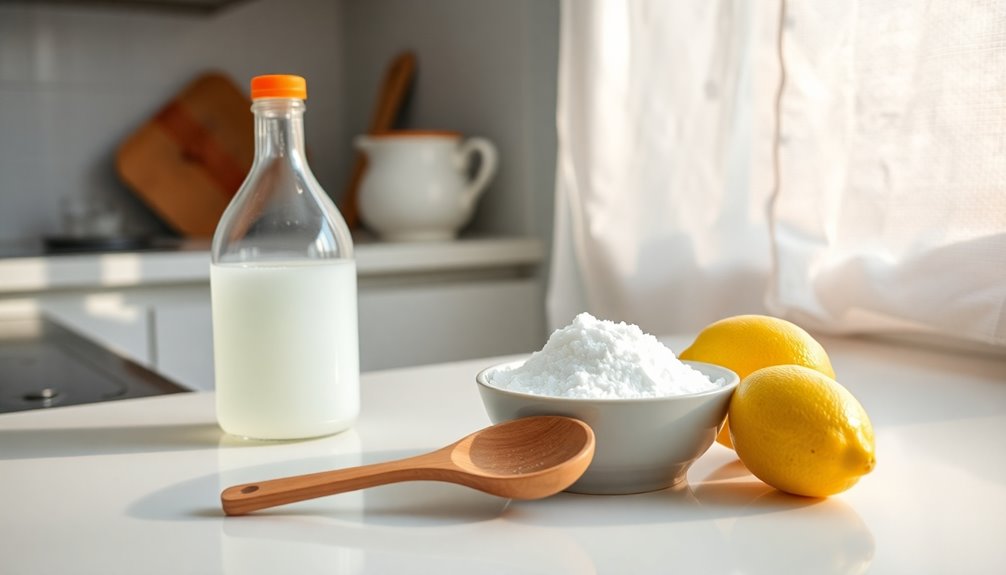
If you've got a bleach stain, acting quickly can make a big difference. You can try home remedies like vinegar or baking soda to tackle the issue effectively. Additionally, using coupon codes can provide significant savings on cleaning supplies and other necessary items. Digital coupons offer access to a wide range of discounts that can help you stock up on stain removal products. Let's explore these methods and others, including fabric dye solutions, to restore your item to its former glory. Additionally, utilizing expense tracking apps can help freelancers manage their finances better while dealing with unexpected costs like stain removal.
Vinegar and Baking Soda
Dealing with a bleach stain can be frustrating, but using common household items like vinegar and baking soda can help restore your fabric.
Start by rinsing the stained area with cold water for several minutes. This step dilutes the bleach and prevents further damage.
Then, try these two effective methods:
- Vinegar Solution: Mix 1 part vinegar with 2 parts water. Soak the stained area in this solution for 30-60 minutes. The vinegar neutralizes the bleach stains, helping to restore the fabric's color. Rinse thoroughly afterward.
- Baking Soda Paste: Combine equal parts baking soda and water to create a paste. Apply it to the bleach stain and let it sit for 15-20 minutes. The baking soda absorbs excess bleach and reduces discoloration.
Always remember to perform a patch test on a hidden area of the fabric before applying these solutions.
These methods can be effective in removing bleach stains without causing additional damage, allowing you to salvage your favorite items with ease.
Rubbing Alcohol Techniques
While vinegar and baking soda are great options for tackling bleach stains, rubbing alcohol offers another effective home remedy. This technique works by transferring dye from the surrounding fabric into the bleach-stained area, potentially helping to restore color and minimize the appearance of the stain.
To use rubbing alcohol, start by conducting a patch test on an inconspicuous area of the fabric. This guarantees that the alcohol won't cause any additional damage.
If the patch test goes well, apply rubbing alcohol to a clean cloth and gently dab the stained area. Avoid rubbing, as this can spread the bleach further and worsen the stain.
Once you've treated the stain, rinse the area with cold water to remove any residue. After rinsing, wash the garment according to its care instructions.
This method is particularly effective on colored fabrics, as it can help blend the bleach stain with the original color of your garment. By following these steps, you can effectively use rubbing alcohol to tackle those pesky bleach stains and breathe new life into your favorite clothes.
Fabric Dye Solutions
When it comes to fixing bleach stains, fabric dye solutions can be a game changer. They can effectively restore color to those stubborn bleach stains, bringing back a touch of your garment's original color.
Here's how you can do it:
- Choose the Right Fabric Dye: Depending on your fabric type, select acid dye for silk or fiber-reactive dye for cotton. This guarantees the dye will adhere correctly.
- Conduct a Patch Test: Before diving in, always do a patch test on a hidden area of the fabric. This helps you confirm compatibility and avoid further damage.
- Apply and Set the Dye: When dyeing larger areas, start with a lighter shade to blend naturally. Rinse thoroughly after application and follow the manufacturer's instructions for setting the dye to achieve that long-lasting restorative color.
For smaller stains, a fabric marker in a matching color can be a quick fix.
With these steps, you can transform your bleach-stained items into something fresh and vibrant again!
Using White Vinegar Effectively
There's a simple yet effective way to tackle bleach stains using white vinegar. By mixing white vinegar with alcohol in a 1:1 ratio, you create a powerful cleaning solution that can help lift those pesky stains.
First, soak a clean cloth in this mixture and gently apply it to the stained area. Be careful not to rub, as this can spread the bleach stains further. It's essential to choose eco-friendly products, as they support sustainable businesses that prioritize environmental responsibility. Additionally, many eco-friendly brands are committed to using sustainable materials that lessen environmental impact.
After applying the solution, wash the garment in cold water to help lift the stain completely. For best results, expose your washed clothes to sunlight, which can enhance the stain removal process by breaking down any remaining bleach residue.
Before using this method, always perform a colorfastness test on a hidden area of the fabric. This simple test guarantees that the vinegar won't cause additional discoloration.
If the fabric holds its color, proceed with treating the stained area. With these steps, you can effectively neutralize the bleach and restore your garment, making white vinegar an essential tool in your stain-fighting arsenal. Additionally, using eco-friendly cleaning methods not only helps with stain removal but also promotes sustainable practices for a healthier environment.
Exploring Bleach Stain Removers
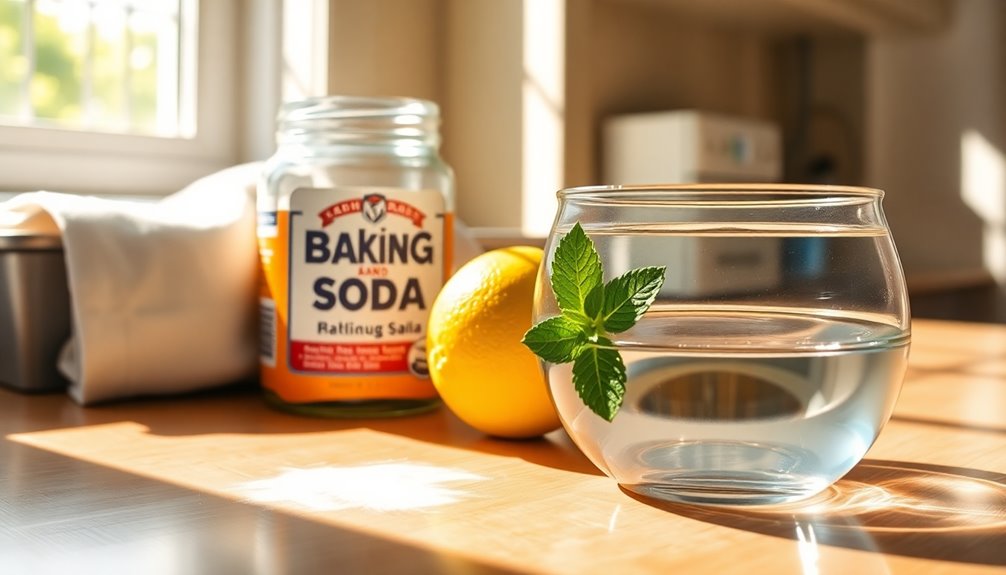
If you're dealing with stubborn bleach stains, bleach stain removers can be a game changer. These products are designed to effectively treat bleach stains on various fabrics.
Here's how to use them:
- Prepare the Solution: Mix the bleach stain remover with water as per the package instructions. This guarantees a safe and effective solution.
- Soak the Stained Garment: Submerge the affected area in the solution for about 90 minutes. This allows the remover to penetrate and break down the stubborn stains. Additionally, using eco-friendly materials in your cleaning products can minimize environmental impact. It's also advisable to check for clear expiration dates on products to ensure effectiveness.
- Rinse and Wash: After soaking, rinse the garment thoroughly to remove any remaining remover, then wash it as usual to guarantee the stain is completely treated.
In some cases, you might need to repeat the stain removal process if the stain persists. Patience is key!
By following these steps closely, you can tackle those pesky bleach stains and restore your garment's appearance. Additionally, considering sustainable and ethical shopping practices can help you find eco-friendly stain removers that are gentle on fabrics and the environment.
Just remember, always check the care label of your fabric before applying any product. Happy cleaning!
Color Correction Methods
Color correction methods offer practical solutions for salvaging fabrics marred by bleach stains.
If you're dealing with small bleach stains, a fabric marker can effectively cover the discolored area. Just match it to the original color for a seamless look.
For slightly larger stains, you might want to try rubbing alcohol to transfer dye from the surrounding fabric into the bleach-stained area, helping to blend the colors and reduce visibility.
If the stain persists, consider applying a fabric dye designed specifically for your fabric type. Remember to test it on an inconspicuous area first to verify compatibility.
For a natural approach, lemon juice can restore some color while also acting as a lightener, but rinse it out thoroughly afterward.
In cases of extensive bleach damage, dyeing the entire garment a darker color can mask the stains completely. Just make sure the dye you choose is appropriate for the fabric type.
Repurposing Stained Fabrics
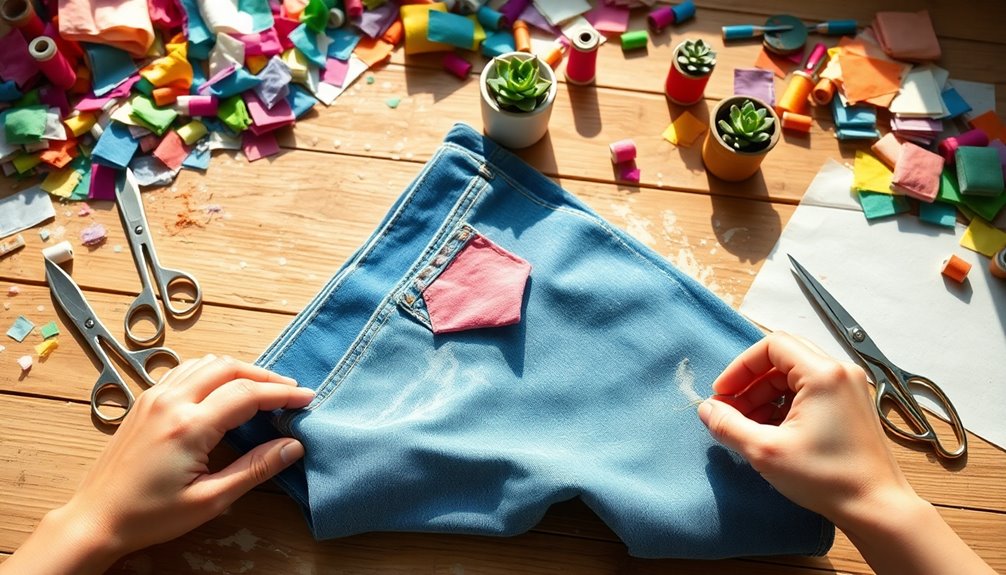
Bleach stains don't have to spell the end for your favorite fabrics. In fact, repurposing stained fabrics can lead to some amazing projects. Here are three creative techniques you can use:
- Reverse tie-dye: Embrace the stain by using a reverse tie-dye method. This technique can transform a ruined garment into a trendy piece that stands out.
- Fabric markers: For smaller bleach stains, grab some fabric markers that match the original color. They're perfect for quick touch-ups, making those imperfections less noticeable.
- Embroidery and appliqué: Use embroidery to mask those stubborn bleach stains. Adding decorative elements not only enhances the design but also distracts from the damage.
Upcycling is another fantastic way to give stained fabrics a new life. Consider turning your old clothes into tote bags or pillow covers.
With a bit of creativity, you can showcase your unique style while minimizing waste. So don't toss out those stained fabrics—get crafty and let your imagination run wild!
When to Seek Professional Help
Knowing when to seek professional help can save you time and prevent further damage to your favorite fabrics. If you've tried multiple DIY solutions without success and those stubborn bleach stains are still visible, it's time to contemplate consulting a professional cleaner who specializes in stain removal.
These experts often have access to advanced equipment and commercial-grade products that can tackle issues home remedies can't resolve.
For valuable or delicate fabrics like silk or wool, it's essential to seek professional help. Attempting to treat these materials on your own can lead to irreversible damage.
Professional cleaning services can guarantee that your items are treated correctly, preserving their integrity.
In some cases, if the bleach stain is large or particularly damaging, tailoring and alteration services might be necessary to salvage the garment. This approach offers a practical solution to keep your cherished pieces in your wardrobe.
Lastly, if the cost of professional cleaning services aligns with the value of your garment, it's often more cost-effective to seek help rather than risk further damage.
Prioritizing damage control can save you both time and money in the long run.
Tips for Preventing Future Stains
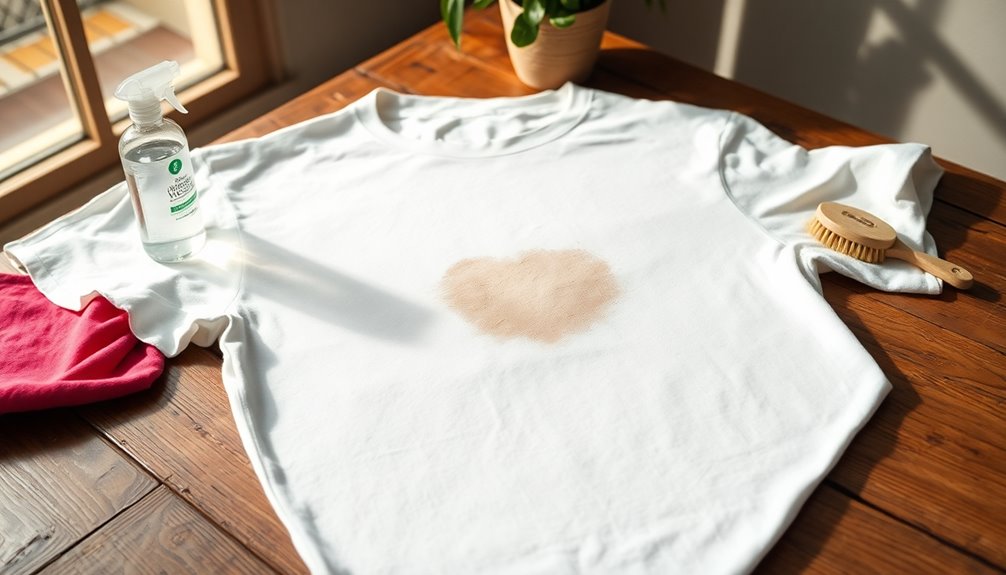
To keep future bleach stains at bay, you need to practice proper bleach usage and storage.
Regularly assess your fabrics to guarantee they're suitable for bleaching, and always follow safety guidelines.
Proper Bleach Usage
When it comes to using bleach safely, proper dilution is essential for protecting your fabrics. Always dilute bleach with water according to the package instructions to minimize the risk of damage and discoloration. This guarantees the right bleach concentration to achieve cleaning without harming your clothes.
To prevent accidental bleach stains, follow these three tips:
- Conduct a patch test: Before applying bleach, test it on an inconspicuous area of the fabric. This will help you see if it can withstand bleach without fading or staining.
- Sort laundry by color: Always separate your garments by color and fabric type. This way, you can prevent accidental bleach exposure, especially during washing or cleaning.
- Avoid colored fabrics: Steer clear of using bleach on colored or dark fabrics, as it can lead to irreversible discoloration and damage.
Additionally, store bleach safely in a secure location away from your fabrics to prevent accidental spills or contact during your cleaning routines.
Safe Storage Practices
Storing bleach properly is just as important as using it safely. To prevent accidental spills, keep bleach and bleach-containing products in a secure cabinet, ideally high up and away from household items like fabrics and clothing. This reduces the risk of splatters that could lead to stains.
Always store bleach in its original container, which should be clearly labeled to avoid any confusion with other cleaning supplies or household items.
When using bleach, make certain to use a dedicated measuring cup. This practice prevents cross-contamination with food or other cleaning products, keeping your environment safe.
Additionally, maintain a dry storage area—moisture can lead to spills or leaks that increase the risk of bleach stains.
Lastly, guarantee proper ventilation in your storage area and avoid placing bleach containers in direct sunlight. Sun exposure can degrade the container over time, making leaks more likely.
Regular Fabric Assessments
Although it might seem tedious, regularly evaluating your fabrics can save you from the headache of future bleach stains. By being proactive, you can catch potential issues before they escalate. Here's how to effectively assess your garments:
- Regularly inspect your clothes for wear and tear or existing stains. Early detection can help prevent further damage from bleach exposure.
- Always read and follow care labels on your clothing. Understanding specific washing and bleaching instructions will minimize the risk of accidental bleach stains.
- Sort laundry by fabric type and color before washing. This avoids cross-contamination of bleach stains, especially with darker or colored items.
Additionally, when using new cleaning products, conduct patch tests on inconspicuous fabric areas to verify compatibility and prevent discoloration.
Store bleach and other cleaning agents safely away from fabrics, and wear protective clothing during cleaning to avoid spills.
Benefits of Professional Laundry Services
Professional laundry services offer numerous advantages that can greatly enhance your laundry experience. By hiring these experts, you save valuable time and effort, allowing you to focus on other important tasks while guaranteeing your garments are cleaned thoroughly.
Professional cleaners use commercial-grade cleaning products and specialized equipment, which effectively remove tough stains from clothes and help restore fabric quality.
Additionally, regular cleaning from professional services helps maintain a consistently clean home environment, reducing the buildup of dirt and allergens. Many services, like Clotheslyne, provide convenient scheduling options through apps, making it easy to get your laundry done without the hassle of traditional methods.
One of the standout benefits is their ability to offer tailored solutions for delicate fabrics and expensive garments. You can trust that your cherished items are treated appropriately, minimizing the risk of damage while guaranteeing they're spotless.
Whether it's a stubborn stain or routine maintenance, professional cleaning services guarantee your garments look their best and last longer. By opting for these services, you're investing in the longevity and appearance of your wardrobe, making it a smart choice for any busy individual.
Conclusion
Fixing a bleach stain can feel like trying to mend a broken vase—challenging but not impossible. By using the right techniques and home remedies, you can breathe new life into your favorite fabrics. Remember, whether you choose to tackle the stain yourself or seek professional help, you've got options. With a little creativity and care, you can turn a mishap into a new opportunity for style. So, don't let those stains hold you back!

